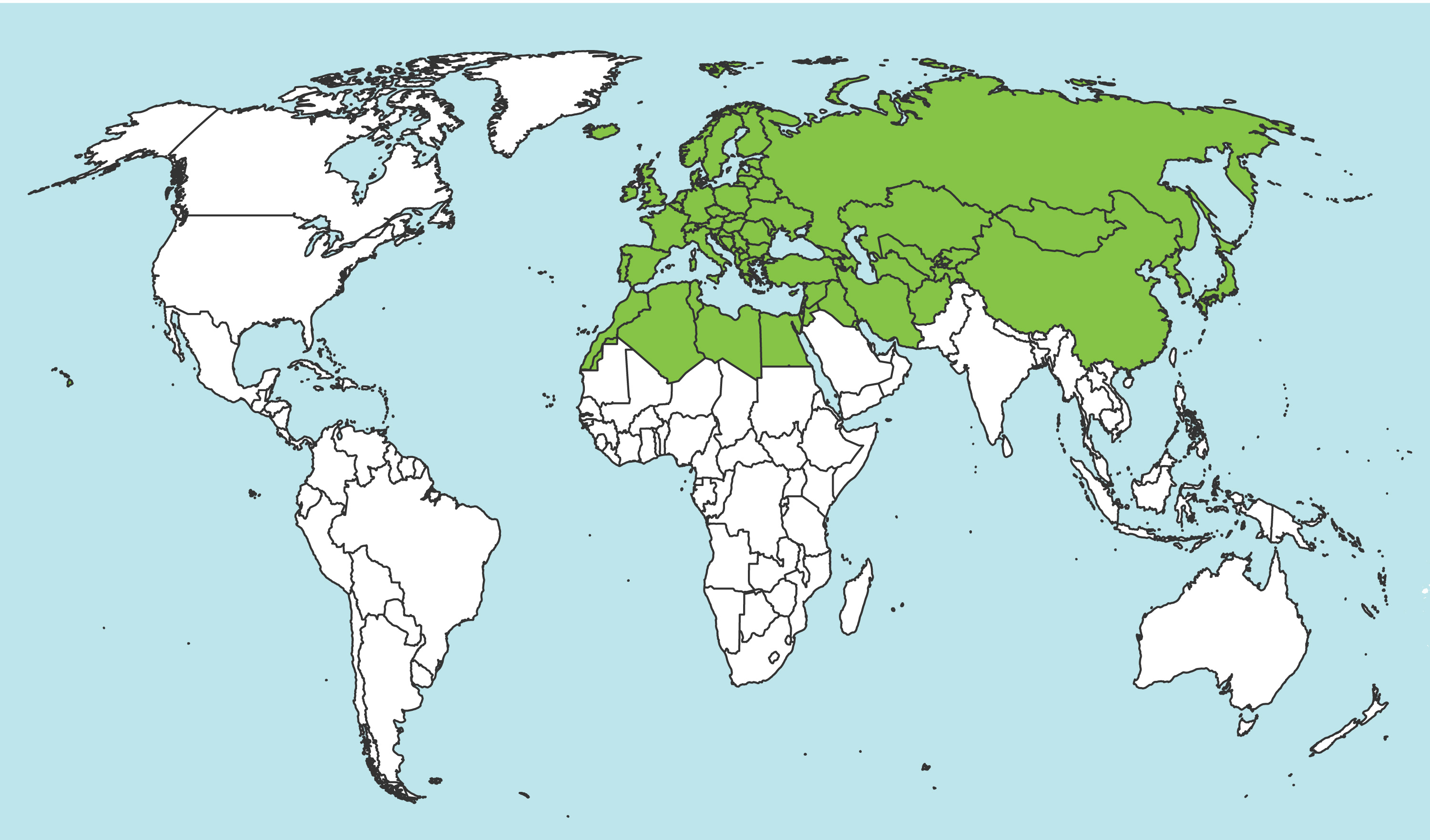Family: Pamphiliidae
Family common name: web-spinning and leaf-rolling sawflies
Subfamily: Cephalciinae
Tribe: Cephalciini
Genus: Cephalcia Panzer, 1803
Subgenera: none
The Pamphiliidae are called the web-spinning and leaf-rolling sawflies because of larval shelter-building behavior.
Though the genus is fairly speciosespeciose:
describing a taxon that includes a high number of species
, Cephalcia is not well-known in North America. They have distinctive larval habits that involve building elaborate nests of webs, leaf material, and frassfrass:
solid larval excrement
, inside of which they feed and keep safe from predators. Some species can be recognized by the style of nest (Eidt 1969Eidt 1969:
Eidt DC. 1969. The life histories, distribution, and immature forms of the North American sawflies of the genus Cephalcia (Hymenoptera: Pamphiliidae). Memoirs of the Entomological Society of Canada 101 (59): 5-56. https://doi.org/10.4039/entm10159fv).
There are 43 described species worldwide, all restricted to the Northern Hemisphere. Ten species occur in North America (Taeger et al. 2010Taeger et al. 2010:
Taeger A, Blank SM, and Liston AD. 2010. World Catalog of Symphyta (Hymenoptera). Zootaxa 2580: 1-1064.).
A key to North American species of Cephalcia is included in Middlekauff 1958Middlekauff 1958:
Middlekauff WW. 1958. The North American sawflies of the genera Acantholyda , Cephalcia , and Neurotoma (Hymenoptera, Pamphiliidae). University of California Publications in Entomology 14 (2): 51-174..
 from above slightly constricted, without two distinct faces, more or less evenly flat from the dorsum to the anterioranterior:
from above slightly constricted, without two distinct faces, more or less evenly flat from the dorsum to the anterioranterior: with 2 apicalapical:
with 2 apicalapical: with 3–4 preapicalpreapical:
with 3–4 preapicalpreapical: tibial spurs (Goulet 1992Goulet 1992:
tibial spurs (Goulet 1992Goulet 1992: width at basebase:
width at basebase: with small inner tooth (Goulet 1992Goulet 1992:
with small inner tooth (Goulet 1992Goulet 1992: membrane wrinkled irregularly at the apexapex:
membrane wrinkled irregularly at the apexapex:Pamphiliidae are recognized by a somewhat quadratequadrate:
square-like or cube-like in shape
 head and tarsal claws, often with inner teeth. Cephalcia can be distinguished from Acantholyda by the lack of a preapicalpreapical:
head and tarsal claws, often with inner teeth. Cephalcia can be distinguished from Acantholyda by the lack of a preapicalpreapical:
close to, but anterior to, the apex
 spur on the inner side of fore legfore leg:
spur on the inner side of fore legfore leg:
the first and anterior-most leg of the body
 and from other genera in the family by the small inner tarsal clawtarsal claw:
and from other genera in the family by the small inner tarsal clawtarsal claw:
sharpened appendage emerging from the apex of the tarsus
 tooth (Goulet 1992Goulet 1992:
tooth (Goulet 1992Goulet 1992:
Goulet H. 1992. The genera and subgenera of the sawflies of Canada and Alaska: Hymenoptera. Symphyta. The insects and arachnids of Canada. Part 20. Agriculture Canada Publication.).
Three PalearcticPalearctic:
describing the region of the northern hemisphere that includes Europe, Asia south to the Himalayas and northern Africa
 Cephalcia species have caused extensive damage to Picea abies (Norway spruce) stands in their native ranges. Cephalcia abietis, also known as the false spruce webworm, has had recorded outbreaks of up to 136,000 acres in Germany and the region formerly known as Czechoslovakia in recent decades (Führer and Fischer 1991). Cephalcia arvensis was responsible for severe defoliation of more than 3700 acres over a six-year period in central Europe (Marchisio et al. 1994Marchisio et al. 1994:
Cephalcia species have caused extensive damage to Picea abies (Norway spruce) stands in their native ranges. Cephalcia abietis, also known as the false spruce webworm, has had recorded outbreaks of up to 136,000 acres in Germany and the region formerly known as Czechoslovakia in recent decades (Führer and Fischer 1991). Cephalcia arvensis was responsible for severe defoliation of more than 3700 acres over a six-year period in central Europe (Marchisio et al. 1994Marchisio et al. 1994:
Marchisio C, Cescatti A, and Battisti A. 1994. Climate, soils, and Cephalcia arvensis outbreaks in Picea abies in the Italian Alps. Forest Ecology and Management 68: 375-384.). Cephalcia masuttii is also documented on Picea abies. Despite being more patchily distributed than the other two species, it has gregariousgregarious:
describing insects in large groups or aggregations
feeding habits that result in extensive damage where it is present (Battisti and Boato 1998Battisti and Boato 1998:
Battisti A and Boato A. 1998. Cephalcia masuttii sp. n. (Hymenoptera: Pamphiliidae), a new web-spinning sawfly living on spruce. European Journal of Entomology 95: 251-262.). Picea abies is introduced to North America, and has a fairly wide distribution in northern regions, so these pest species would find ample host material if introduced (Sullivan 1994Sullivan 1994:
Sullivan J. 1994. Larix decidua . In: Fire Effects Information System. U.S. Department of Agriculture, Forest Service, Rocky Mountain Research Station, Fire Sciences Laboratory.).
Cephalcia lariciphilia in Europe and Asia feeds heavily and gregariously on Larix decidua (European larch) and has historically reached outbreak levels. There are currently no records of Cephalcia on larch in North America. Larix decidua is grown in the northern United States and southern Canada as a timber species, and this sawfly, if introduced, could potentially damage this and other native larch species (Georgis and Hague 1988Georgis and Hague 1988:
Georgis R and Hague NGM. 1988. Field evaluation of Steinernema feltiae against the web-spinning larch sawfly Cephalcia lariciphila . Journal of Nematology 20 (2): 317-320., Sullivan 1994Sullivan 1994:
Sullivan J. 1994. Larix decidua . In: Fire Effects Information System. U.S. Department of Agriculture, Forest Service, Rocky Mountain Research Station, Fire Sciences Laboratory., Holusa and Kuras 2010Holusa and Kuras 2010:
Holusa J and Kuras T. 2010. Diurnal behavior of Cephalcia lariciphila (Hymenoptera: Pamphiliidae): relation to climatic factors and significance for monitoring. European Journal of Forest Research 129: 243-248. https://doi.org/10.1007/s10342-009-0321-3).
Cephalcia pinivora is a pest of Pinus massoniana in China, which is not widely grown in North American forests. It is unknown if there are alternative hosts (Xiao and Zeng 1998Xiao and Zeng 1998:
Xiao G and Zeng C. 1998. A new species of the genus Cephalcia (Hymenoptera: Pamphiliidae) from China. Forest Research 11 (5): 488-490.)
Larvae feed on needles of numerous species of Pinaceae including: Pinus contorta (lodgepole pine), Pinus ponderosa (ponderosa pine), Pinus resinosa (red pine), Pinus banksiana (jack pine), Pinus strobus (white pine), Picea glauca (white spruce), Picea rubens (red spruce), Picea engelmanni (Engelmann spruce), Picea pungens (blue spruce), Picea mariana (black spruce), Picea sitchensis (Sitka spruce), Abies balsamea (balsam fir), and Tsuga canadensis (eastern hemlock) (Eidt 1969Eidt 1969:
Eidt DC. 1969. The life histories, distribution, and immature forms of the North American sawflies of the genus Cephalcia (Hymenoptera: Pamphiliidae). Memoirs of the Entomological Society of Canada 101 (59): 5-56. https://doi.org/10.4039/entm10159fv).
The female makes a small slit in the side of a mature needle and deposits the egg so that the membrane gets caught in the slit, ensuring the egg stays in place on the outside of the needle, yet allowing the egg to be in contact with vascular tissue and obtain moisture. After hatching, larvaelarva:
the immature stage of holometabolous insects
 commence building a structure for protection. Cephalcia larvaelarva:
commence building a structure for protection. Cephalcia larvaelarva:
the immature stage of holometabolous insects
 are able to spin silk, and this silk is used to transport substrate and to build a shelter of needles in which they safely feed and molt. They eat by using mandibles to cut small needles at the basebase:
are able to spin silk, and this silk is used to transport substrate and to build a shelter of needles in which they safely feed and molt. They eat by using mandibles to cut small needles at the basebase:
the beginning or most proximal area of any structure
, bringing the needle into their shelter, and feeding from basebase:
the beginning or most proximal area of any structure
to apexapex:
the end or most distal area of any structure
(Eidt 1969Eidt 1969:
Eidt DC. 1969. The life histories, distribution, and immature forms of the North American sawflies of the genus Cephalcia (Hymenoptera: Pamphiliidae). Memoirs of the Entomological Society of Canada 101 (59): 5-56. https://doi.org/10.4039/entm10159fv).
Mature larvaelarva:
the immature stage of holometabolous insects
 drop to the ground and burrow into the soil to a depth of 5–15 cm. These prepupae then build a small overwintering cellcell:
drop to the ground and burrow into the soil to a depth of 5–15 cm. These prepupae then build a small overwintering cellcell:
1. a membranous area of the wing between veins, 2. a small cavity or closed space
 of soil and silk. In spring, they pupate and emerge. Adults fly in early summer, May to June, and generally only live for about 5 days. Many Cephalcia are univoltineunivoltine:
of soil and silk. In spring, they pupate and emerge. Adults fly in early summer, May to June, and generally only live for about 5 days. Many Cephalcia are univoltineunivoltine:
describing an insect with a life cycle of one generation per year
, but some have two or more year-long life cycles (Eidt 1969Eidt 1969:
Eidt DC. 1969. The life histories, distribution, and immature forms of the North American sawflies of the genus Cephalcia (Hymenoptera: Pamphiliidae). Memoirs of the Entomological Society of Canada 101 (59): 5-56. https://doi.org/10.4039/entm10159fv).
World: The genus is common in northern and central Europe, eastwards through northern Asia to China (Van Achterberg and Van Aartsen 1986Van Achterberg and Van Aartsen 1986:
Van Achterberg C and Van Aartsen B. 1986. The European Pamphiliidae (Hymenoptera: Symphyta), with special reference to the Netherlands. Zoologische Verhandelingen 234: 3-98.).
North America: Cephalcia are known from the northern United States and southern Canada, generally following the range of coniferconifer:
a usually evergreen tree characterized by reproductive cones; e.g., pine, fir, spruce, larch, etc.
forests (Eidt 1969Eidt 1969:
Eidt DC. 1969. The life histories, distribution, and immature forms of the North American sawflies of the genus Cephalcia (Hymenoptera: Pamphiliidae). Memoirs of the Entomological Society of Canada 101 (59): 5-56. https://doi.org/10.4039/entm10159fv).
Map data from: GBIF.org (26 June 2019) GBIF Occurrence Download Cephalcia
Details about data used for maps can be found here.